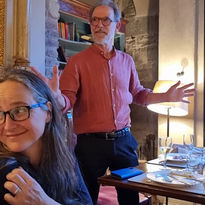
GEM Conference
Are we making a difference?
13th - 14th June 2023
Centro Congressi Bergamo
Bergamo, Italy
A Collective Success: Thank You!
OVERVIEW
The recent devastating earthquake sequence that affected Türkiye and Syria reminded us again of the importance of our vision to reduce earthquake risk worldwide. This conference brought leading researchers and risk management experts worldwide together to discuss recent developments and future directions on the road to earthquake resilience.
The event featured sessions on GEM’s new global earthquake hazard and risk models, maps, and databases; applications to risk reduction and management; and the future of earthquake risk assessment science and practice.
speakers & panelists
Session Title
presentations
GEM CONFERENCE: Are we making a difference?
June 13th - 14th, 2023
Add to calendar
Presentation | Speaker | Organisation/Role |
|---|---|---|
Lessons learned from the 2023 Kahramanmaraş, Türkiye earthquakes: Modeling aspects of insured portfolio losses | Sinan Akkar | Turk Reinsurance Inc.,
Principal Catastrophe Modeler (keynote speaker) |
DASK National Insurance perspective of Turkey EQ | Ahmet Buğra Ceyhan | DASK,
Claims and Catastrophe Project Management Specialist |
Update of the Global Hazard Model | Marco Pagani | GEM
Hazard Team Coordinator |
Update of the Global Risk Model | Vitor Silva | GEM
Risk Team Coordinator |
Launch of the Earthquake Scenarios Database | Catalina Yepes | GEM
Seismic Risk Engineer |
Canadian Earthquake Risk Model | Tiegan Hobbs | Natural Resources Canada (NRCan),
Research Scientist |
Colombia Earthquake Hazard model + Cali | Miguel Mora | I+R Consultores en Ingeniería y Riesgos,
Seismic Risk Engineer |
Site-specific seismic hazard assessment for nuclear and hydropower facilities in France | Paola Traversa | Electricité
de France (EdF),
Seismologist |
Triggered or secondary effects: Tsunami | Stefano Lorito | Istituto Nazionale di Geofisica e Vulcanologia (INGV),
Researcher |
Triggered or secondary effects: Liquefaction | Ellen Rathje | University of Texas at Austin, Geotechnical Engineering, Professor |
Triggered or secondary effects: Landslide | Farrokh Nadim | NGI – Norwegian Geotechnical Institute,
Technical Director |
Incorporation of NASA products in global hazard and risk assessment | Shanna McClain | NASA,
Disasters
Program Manager |
Keynote Lecture: International Macroseismic Scale | David Wald | United States Geological Survey (USGS), Research Geophysicist (Keynote speaker) |
Systemic or cascading infrastructure risk | Astha Poudel | Aristotle
University of Thessaloniki, Systemic Risk Researcher |
Using GEM products to support rapid loss assessment | Alberto Michelini | Istituto Nazionale di Geofisica e Vulcanologia (INGV) ARISTOTLE, Director of Research
|
Future Exposure and Risk to natural hazards | Alejandro Calderon | GEM,
Seismic Risk
Engineer |
Click the presentation title to download the PDF.
POSTERS & Demos
Showcasing GEM Integration, Innovative Tools, and Advanced Data for Enhanced Hazard and Risk Assessment
Poster
TREQ Project Understanding earthquake risk at the urban and city levels
Alejandro Calderon
Seismic Risk Engineer
GEM
Poster
New Frontiers of Earthquake Model development: Aon Impact Forecasting and GEM partnership
Athanasios Gkimprixis
Earthquake Catastrophe Model Developer
Aon Impact Forecasting
Poster
Leveraging and Improving GEM Tools to Model and Communicate Integrated Risk and Resilience to Earthquakes
Christopher Burton
Professor
University of Connecticut
Demo
Interactive earthquake demo, simulating how Safehub sensors work using a K'NEX Building Model
Andy Thompson
CEO and Co-Founder
Safehub
Demo
GEM Foundation Global Interactive Maps
Paul Henshaw
Director of Technology and Development
GEM
Poster
Exploring new data analysis techniques on an extended earthquake catalogue for evaluating seismic hazard in Europe
Jochen Woessner
Senior Principal Modeller
Moody’s RMS
Poster
Applications of Global Economic Disruption Index (GEDI) in Multi-Hazard Disaster Response, Mitigation and Planning
Shubaroop Ghosh
Vice President of Data Services
ImageCat
Demo
Multi-hazard risk assessment and mapping in West Bank & Gaza using GEM standards, models, tools & technologies
Jamal Dabbeek
Professor
An-Najah National University
Demo
NEEV a digital platform to remote resilience and sustainability within low income Communities
Marco Ferrario
Co-Founder
MHS Global Impact
Demo
RiskProfiler.ca Sharing earthquake risk assessment results in Canada
Malaika Ulmi
Public Safety Geoscience Program Manager
NRCan




Location
Transportation
TRANSFERS FROM BERGAMO AIRPORT TO BERGAMO
https://www.atb.bergamo.it/en/atb-network/tourism-in-bergamo/airport-bus
BERGAMO AIRPORT WEBSITE
https://www.milanbergamoairport.it/en/
ORIOSHUTTLE (FROM MALPENSA AIRPORT TO BERGAMO ORIO AL SERIO AIRPORT)
http://www.orioshuttle.com/_eng/
CAPITAL OF ITALIAN CULTURE FOR 2023
https://bergamobrescia2023.it/en/
resources
Conference resources for downloading
Videos
Galleries
Maps
Recording
Videos
A series of video clips capturing some of the reactions to the release of GEM's new earthquake hazard and risk maps, models, and database including demos of innovative tools, and advanced data for enhanced hazard and risk assessment. Watch on YouTube to read the video description.
2023 GEM Conference: video clips
2023 GEM Conference: video clips


John Schneider GEM

Sonia Talwar NRCan

Shanna McClain NASA

Sinan Akkar Turk Insurance Inc.
Galleries
GEM2023 in Photos:
Photo credit: GEM
Maps
Preview | Name | Category |
|---|---|---|
Global Earthquake Hazard Map | Map | |
Global Earthquake Risk Map | Map | |
Global Exposure Model | Model | |
Global Vulnerability Model | Model | |
Country-Territory Seismic Risk Profiles | Dataset |
Recording
Day 1, June 13th, 2023 Introduction and Session 1
Day 2 June 14th, 2023, Sessions 2 and 3
























































































